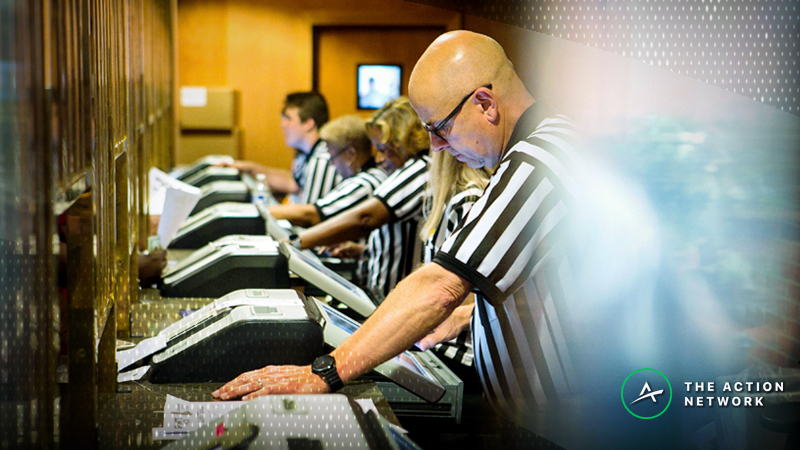Over the past few years, the emergence of daily fantasy sports has led to a renaissance for conventional sports betting. The anti-gambling stigma that existed for decades is fading in American popular culture, opening the door for a massive, multibillion-dollar legal sports betting industry to emerge.
With sports betting now legal in many states, millions of sports fans will be looking to enter the betting market for the first time. But where do you begin if you're unfamiliar with the terminology?
Here's an introduction into how to bet on sports. We'll be adding to this series in the coming weeks.
How to Bet on Sports for Beginners: 12 Tips
Use the links below to jump to each section.
- Favorites vs. Underdogs
- Spreads
- Moneylines
- Over/Under
- What Does -110 Mean?
- How to Place a Bet
- Where to Place a Bet
- How Much to Bet
- Rotation Numbers
- Line Moves
- Shopping for Lines
- Know Your Strengths/Weaknesses
1. Favorites vs. Underdogs
When the oddsmakers release a betting line on a game, the first thing they do is decide which team should be the favorite and which should be the underdog.
The favorite is the team that is expected to win the game and will get a minus sign next to its odds, while the underdog is expected to lose and gets a plus sign. If the game is a toss-up, books will open it as a "pick" or "pick'em."
Click to return to table of contents.
2. Spreads
There are two different ways to bet on a favorite or an underdog. The first is the point spread, which is a bet on the margin of victory. A favorite "gives" points, while an underdog "gets" points.
For example, say the Patriots are 7-point favorites (-7) against the Jets.
If you bet on the Patriots, they need to win the game by 8 points or more for you to win your bet. If the Patriots win by 8 points or more, you "cover." If the Patriots win by exactly 7 points, that is called a "push," which means you get back the money you originally bet.
If the Patriots win by 6 points or fewer (or lose the game straight-up), you lose your bet.
On the flip side, if you bet on the Jets "plus the points" (+7), you need the Jets to either win the game lose by six points or fewer for you to win (or cover) your bet.
Spreads are available for all sports, but they are predominantly used when betting on football and basketball.
Click to return to table of contents.
3. Moneylines
The second way to bet on a favorite or an underdog is on the moneyline. This is based solely on which team will win the game. Favorites are given a "minus" designation, such as -150, -200 or -500. If a favorite is -200, that means you have to risk $200 to win $100. If the favorite wins, you get $100, but if the favorite loses, you're out $200. Because favorites are expected to win, you assume more risk when betting on them.
Underdogs are given a "plus" designation, such as +150, +200 or +500. If an underdog is +200, that means if you bet $100 on them and they win the game, you get $200. If they lose the game, you lose only the $100 that you risked. Because underdogs are expected to lose, there is more of a reward when betting on them.
Moneylines are available for all sports, but they are predominantly used when betting on baseball, hockey and soccer.
Click to return to table of contents.
4. Over/Unders (Totals)
In addition to setting a line for the favorite and the underdog, oddsmakers will also set a total number of points scored in a game by both teams combined. This is called the total or over/under.
Bettors can then wager on whether or not the game will go Over or Under the total.
For example, an NBA game between the Celtics and Bulls might have a total of 215. You could either bet the Over 215 or the Under 215. If you bet the Over 215 and the total points scored end up being 216 or higher, you win your bet. If the total points scored are 214 or fewer, you lose.
Click to return to table of contents.
5. What is the -110 number listed next to my bet?
The oddsmakers put a "tax" on every bet, which is typically called the "juice," "takeout" or "vig" (short for "vigorish"). The juice is the commission you have to pay to the sportsbook for them to accept your wager.
Say the Duke Blue Devils are -5 (-110) … that means if you want to bet on Duke as a 5-point favorite, you need to risk $110 to win $100.
The juice can also be a positive number, such as Penn State -7 (+110). That means if you bet $100 on Penn State as a 7-point favorite and it covers, you win $110. If it loses, you lose only the $100 that you risked.
Click to return to table of contents.
6. How to Place a Bet
With legalized sports betting spreading across America, sports bettors have never had more options to take advantage of. To see if sports betting is legal where you live, check out our state-by-state tracker.
Some of the biggest states that have legalized mobile wagering include Colorado, New Jersey, Pennsylvania, Indiana and West Virginia. The sportsbooks highlighted below are all trustworthy legal shops that take bets online.
Click to return to table of contents.
7. Where to Place a Bet: Best Online Sportsbooks
Click to return to table of contents.
8. How Much to Bet
In the end, you have the final say on how much to risk on a game, but a good rule is risk only what you can afford to lose. Sports betting is a marathon, not a sprint. There will be good days and bad days. As a result, we recommend a flat-betting approach.
This means betting the same amount on every game and risking only 1% to 5% of your bankroll per play (the bankroll is the starting amount you have at your disposal to bet with). For example, if you are starting with a bankroll of $100, you should risk no more than $5 per game.
By employing a flat-betting approach, bettors guard themselves against losing their entire bankroll during a bad stretch, but also set themselves up for a positive return on investment (ROI) when they're doing well.
Click to return to table of contents.
9. Rotation Numbers
Rotation numbers are what's listed to the left of a team on the board. They are also referred to as the NSS number or Vegas ID number. They are unique to the team, sport and league, and universal across most sportsbooks.
For example, you might see the number "312" listed next to the Bruins -120. If you're at a casino and want to bet $100 on the Bruins, walk up to the window with your money and say, "$100 on 312, Bruins -120."
Click to return to table of contents.
10. Lines Move in Real Time
Much like stocks on Wall Street, the sports betting market is fluid. Throughout the day, bookmakers will adjust the odds depending on the action they're taking and other news, such as injuries and weather. For example, if the Vikings open as 7-point favorites and the vast majority of bets are on the Vikings, you might see the Vikings' line move from -7 to -7.5. The line could move even further to -8, or it could be "bought back" to -7.
You can monitor betting data for every game in real time on our live odds page or in our mobile app (download here).
Click to return to table of contents.
11. Shop for the Best Line
Lines can vary based on the sportsbook, because different books have different clienteles. As a result, one book may post the Cavs -8 while another has -7.5. Having access to more than one sportsbook allows you to shop for the best line. Getting an extra half-point might not seem like a huge deal, but it adds up over the long haul and increases your chances of winning.
Our live odds pages will automatically surface the best line for every game.
Click to return to table of contents.
12. Identify Your Strengths and Weaknesses
This isn't Monopoly money, so you want to make sure you're tracking your progress. The easiest way to do that is with our award-winning (and free!) app, which has awesome features like live bet cover probability and odds shopping, it also lets you track all of your bets across nearly every sport.
And that’s valuable because you can identify where your strengths and weaknesses are as you start betting. Are you more successful betting on the NFL or NBA? Do you thrive when taking player props or over/unders? These are all a good thing to know, and it can allow you to maximize your winnings.
Click to return to table of contents.



















































